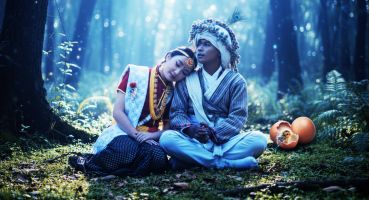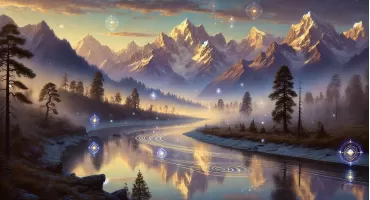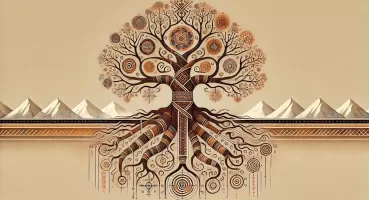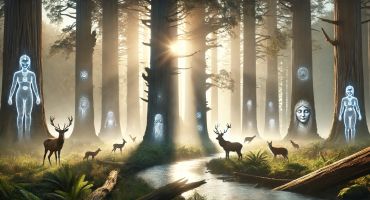The inhabitants of the grand Himalayan belt, from the highlands of Ladakh in the west to the narrow valleys of Arunachal Pradesh to the east, and squeezed between the great Tibetan plateau to the north and the vast Gangetic plains to the south, have enjoyed a true democratic nature of religious harmony for hundreds of years, if not thousands. The people of the Himalayas have always chosen to follow religious beliefs that have suited them, individually or socially. Even today, in this belt, name a belief and you will find someone following it. Influences from different belief systems seem to thrive greatly amongst the ever accommodating, simple, and God-fearing people from the abode of the snow.
However, it wasn’t always so; at least not in the case of Shamanism and Vajrayana Buddhism in Tibet. From the mythical legend of the journey of Ngathi Tsanpo, a Kaurava prince from the epic of Mahabharat, who fled north, after the Kurukshetra war, and founded Yarlung Dynasty as the first King of Tibet, to the inception of Vajrayana in the 7th Century AD, and to the present time of the 14th Dalai Lama, Tibet has lived through the period of a radical shift from its occultic Shamanistic faith of Bon, to an institutionalized religious system of different schools of Tibetan Buddhism and ecclesiastical philosophy today.
From the Totemism of Africa, Tengrism of Mongolia, Bon of Tibet, Animism of the Himalayas; different names with similar practices can be found in the widespread beliefs among the people of these lands, who were afraid of and prayed to the various manifestations of the forces of nature, the living and the dead alike.

In recent memory, from the written scriptures of Vajrayana tantras, these beliefs began to slowly wane in the Tibet-Himalayan region after the arrival of a great tantric guru from the western Himalayas; the one who is revered today as Guru Rinpoche, the Precious Master. Although the Vajrayana tantras originated in India around the 5th Century AD, the principal Lotsawas (translators of Buddhist texts) from Tibet, like the great Sambhota, Janasutra, Vairotsana, Yudra Nyingpo, Rinchen Zangpo, and Marpa among many in between 7th to 12th Century AD, contributed greatly to give the form and structure of the traditionally oral method of teaching.
In Christianity, there is the transition from the Old Testament, where the Book of Leviticus talks greatly of sacrificial rituals and festivals to the New Testament, where Lord Jesus Christ ends these traditions with his ultimate sacrifice for the sins of mankind. In Buddhism, there is actually an interesting antithesis in its narrative vis-à-vis Christianity. While the Tripitaka chronicles the life and philosophy of Lord Buddha who, himself lived and preached the life of middle path and compassion, in an analogous way like Lord Jesus Christ did with righteousness and love, in the New Testament; the later chronicled tantric texts of the Vajrayana Buddhism, like the Kriya Tantra, Dzongchen Tantra, Mahayoga Tantra, and so on are replete with symbolic sacrificial rituals, derived from Bon, which are reminiscent of the Old Testament.
How and why did this transformation occur has, in theory, much to do with the ubiquitous practice of shamanic tradition of Bon in Tibet. One of the most fascinating legends of this transition can be found in the account of the life of Jetsun Milarepa, who having mastered sorcery based on Bon practices, later regretted and went through a rigorous atonement to get accepted as a student of Marpa, and finally becoming a great lineage holder of Tibetan Buddhism himself.

Although Bon predates Buddhism, they have both co-existed in a paradoxical way by their contradictory beliefs but converging in ritualistic practices. An interesting example to illustrate the case is the usage of offering the Torma to the protector deities. Incidentally, the Torma offering is a pacifistic Buddhist version of the bloody animal sacrifices of the erstwhile Bon tradition. Today, even the Bon of the modern environment has taken a non-violent approach to appeasing its deities. The Yungdrung Kundraling Bon Monastery in South Sikkim, one of the seventeen existing Bon monasteries in the Himalayan belt, can be mistaken for a Buddhist monastery. Only the keen eyes and subject experts can spot the differences.
Another convergence in practice is the usage of Phurba (Vajrakilaya) or the ritual dagger, which is widely accepted as the object popularized by Guru Rinpoche, but at the same time has a history in Bon rituals preceding the Vajrayana tradition.
Although not commonly heard in the popular retelling of the spiritual history of the Himalayas, the mythical founder of Bon, Tonpa Shenrab, today, draws similar retelling of his birth and life, in the same vein as the lives of Guru Rinpoche and Shakyamuni Buddha. Like I said, for the ever-accommodating and simple people of the Himalayas, faith is not a subject to challenge. Hence, Tonpa Shenrab, co-exists today alongside Guru Padmasambhva & Buddha.

One of the most important factors in keeping with the harmony of beliefs in the Himalayas is the acceptance that God is beyond human understanding. The people of the mountains don’t try to question the existence of Gods, and their designs on humans. Both the Bon and the Buddhist believe in life after death. Both believe in the celestial universe, deities, sentient beings, and the sum of their appeasement. Both inherently believe in karma and the principle of cause and effect.
This synergy of beliefs can be a great lesson for the world today. When there is a chronicled schism within some major religions due to their beliefs, here are Bon and Buddhism, with differences in metaphysics, yet united in people and practices. This is the symbiosis that the world needs in modern times.





Thank you,very interesting Françoise
Thank you for reading!
Fascinating read! I’m fascinated by the intersections of pre-Buddhist and contemporary Buddhist practice in these regions so thank you for taking the time to write this up!
I am glad you found this informative. Thank you for reading!